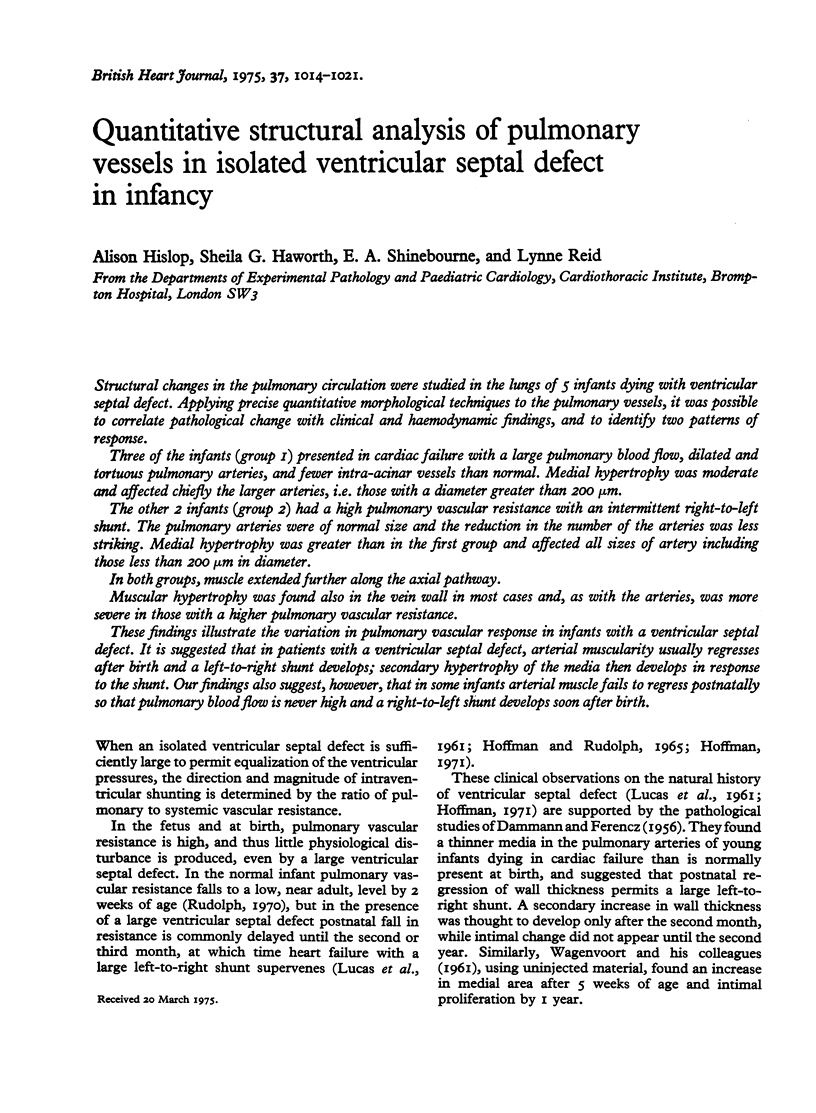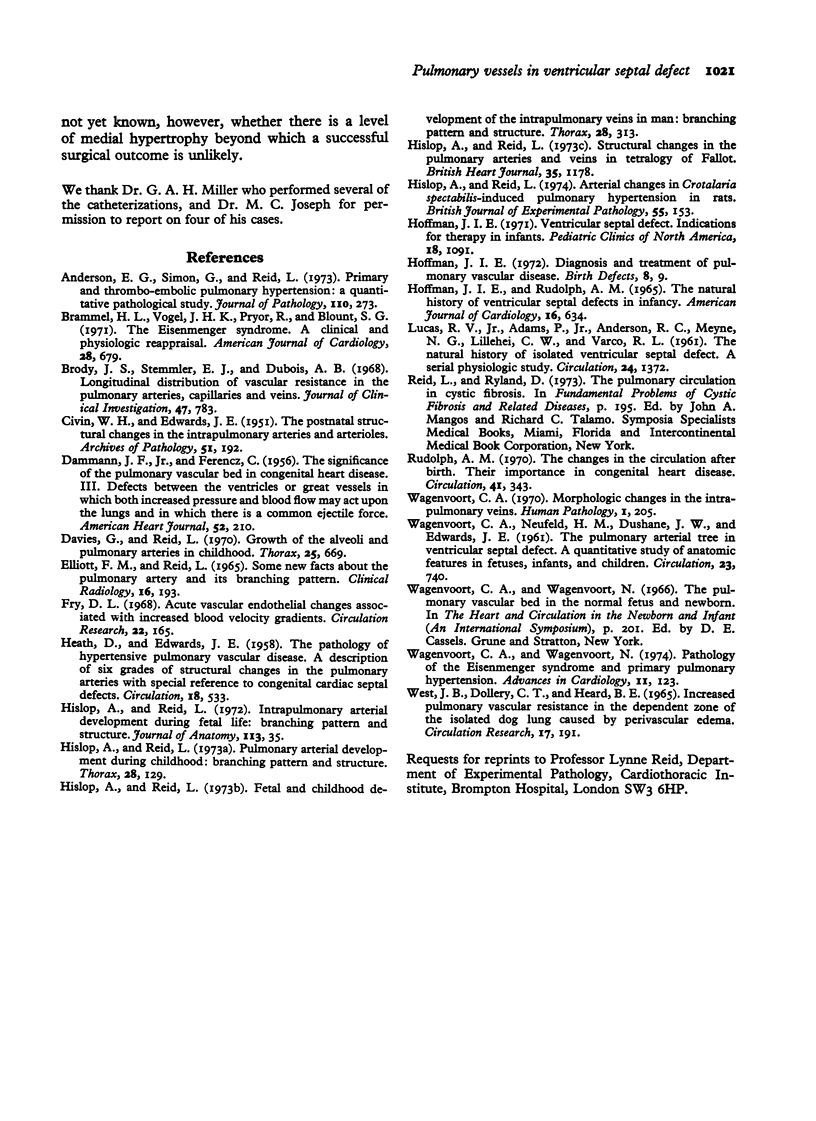Abstract
Structural changes in the pulmonary circulation were studied in the lungs of 5 infants dying with ventricular septal defect. Applying precise quantitative morphological techniques to the pulmonary vessels, it was possible to correlate pathological change with clinical and haemodynamic findings, and to identify two patterns of response. Three of the infants (group I) ppresnted in cardiac failure with a large pulmonary blood flow, dilated and tortuous pulmonary arteries, and fewer intra-acinar vessels than normal. Medial hypertrophy was moderate and affected chiefly the larger arteries, i.e. those with a diameter greater than 200 mum. The other 2 infants (group 2) had a high pulmonary vascular resistance with an intermittent right-to-left shunt. The pulmonary arteries were of normal size and the reduction in the number of the arteries was less striking. Medial hypertrophy was greater than in the first group and affected all sizes of artery including those less than 200 mum in diameter. In both groups, muscle extended further along the axial pathway. Muscular hypertrophy was found also in the vein wall in most cases and, as with the arteries, was more severe in those with a higher pulmonary vascular resistance. The findings illustrate the variation in pulmonary vascular response in infants with a ventricular septal defect. It is suggested that in patients with a ventricular septal defect, arterial muscularity usually regresses after birth and a left-to-right shunt develops; secondary hypertrophy of the media then develops in reaponse to the shunt. Our findings also suggest, however, that in some infants arterial muscle fails to regress postnatally so that pulmonary blood flow is never high and a right-to-left shunt develops soon after birth.
Full text
PDF







Images in this article
Selected References
These references are in PubMed. This may not be the complete list of references from this article.
- Brammell H. L., Vogel J. H., Pryor R., Blount S. G., Jr The Eisenmenger syndrome. A clinical and physiologic reappraisal. Am J Cardiol. 1971 Dec;28(6):679–692. doi: 10.1016/0002-9149(71)90057-9. [DOI] [PubMed] [Google Scholar]
- Brody J. S., Stemmler E. J., DuBois A. B. Longitudinal distribution of vascular resistance in the pulmonary arteries, capillaries, and veins. J Clin Invest. 1968 Apr;47(4):783–799. doi: 10.1172/JCI105773. [DOI] [PMC free article] [PubMed] [Google Scholar]
- DAMMANN J. F., Jr, FERENCZ C. The significance of the pulmonary vascular bed in congenital heart disease. III. Defects between the ventricles or great vessels in which both increased pressure and blood flow may act upon the lungs and in which there is a common ejectile force. Am Heart J. 1956 Aug;52(2):210–231. doi: 10.1016/0002-8703(56)90260-5. [DOI] [PubMed] [Google Scholar]
- Davies G., Reid L. Growth of the alveoli and pulmonary arteries in childhood. Thorax. 1970 Nov;25(6):669–681. doi: 10.1136/thx.25.6.669. [DOI] [PMC free article] [PubMed] [Google Scholar]
- ELLIOTT F. M., REID L. SOME NEW FACTS ABOUT THE PULMONARY ARTERY AND ITS BRANCHING PATTERN. Clin Radiol. 1965 Jul;16:193–198. doi: 10.1016/s0009-9260(65)80042-3. [DOI] [PubMed] [Google Scholar]
- Fry D. L. Acute vascular endothelial changes associated with increased blood velocity gradients. Circ Res. 1968 Feb;22(2):165–197. doi: 10.1161/01.res.22.2.165. [DOI] [PubMed] [Google Scholar]
- HEATH D., EDWARDS J. E. The pathology of hypertensive pulmonary vascular disease; a description of six grades of structural changes in the pulmonary arteries with special reference to congenital cardiac septal defects. Circulation. 1958 Oct;18(4 Pt 1):533–547. doi: 10.1161/01.cir.18.4.533. [DOI] [PubMed] [Google Scholar]
- Hislop A., Reid L. Arterial changes in Crotalaria spectabilis-induced pulmonary hypertension in rats. Br J Exp Pathol. 1974 Apr;55(2):153–163. [PMC free article] [PubMed] [Google Scholar]
- Hislop A., Reid L. Fetal and childhood development of the intrapulmonary veins in man--branching pattern and structure. Thorax. 1973 May;28(3):313–319. doi: 10.1136/thx.28.3.313. [DOI] [PMC free article] [PubMed] [Google Scholar]
- Hislop A., Reid L. Intra-pulmonary arterial development during fetal life-branching pattern and structure. J Anat. 1972 Oct;113(Pt 1):35–48. [PMC free article] [PubMed] [Google Scholar]
- Hislop A., Reid L. Pulmonary arterial development during childhood: branching pattern and structure. Thorax. 1973 Mar;28(2):129–135. doi: 10.1136/thx.28.2.129. [DOI] [PMC free article] [PubMed] [Google Scholar]
- Hislop A., Reid L. Structural changes in the pulmonary arteries and veins in tetralogy of Fallot. Br Heart J. 1973 Nov;35(11):1178–1183. doi: 10.1136/hrt.35.11.1178. [DOI] [PMC free article] [PubMed] [Google Scholar]
- Hoffman J. I. Ventricular septal defect. Indications for therapy in infants. Pediatr Clin North Am. 1971 Nov;18(4):1091–1107. [PubMed] [Google Scholar]
- LUCAS R. V., Jr, ADAMS P., Jr, ANDERSON R. C., MEYNE N. G., LILLEHEI C. W., VARCO R. L. The natural history of isolated ventricular septal defect. A serial physiologic study. Circulation. 1961 Dec;24:1372–1387. doi: 10.1161/01.cir.24.6.1372. [DOI] [PubMed] [Google Scholar]
- Rudolph A. M. The changes in the circulation after birth. Their importance in congenital heart disease. Circulation. 1970 Feb;41(2):343–359. doi: 10.1161/01.cir.41.2.343. [DOI] [PubMed] [Google Scholar]
- WAGENVOORT C. A., NEUFELD H. N., DUSHANE J. W., EDWARDS J. E. The pulmonary arterial tree in ventricular septal defect. A quantitative study of anatomic features in fetuses, infants. and children. Circulation. 1961 May;23:740–748. doi: 10.1161/01.cir.23.5.740. [DOI] [PubMed] [Google Scholar]
- WEST J. B., DOLLERY C. T., HEARD B. E. INCREASED PULMONARY VASCULAR RESISTANCE IN THE DEPENDENT ZONE OF THE ISOLATED DOG LUNG CAUSED BY PERIVASCULAR EDEMA. Circ Res. 1965 Sep;17:191–206. doi: 10.1161/01.res.17.3.191. [DOI] [PubMed] [Google Scholar]
- Wagenvoort C. A. Morphologic changes in intrapulmonary veins. Hum Pathol. 1970 Jun;1(2):205–213. doi: 10.1016/s0046-8177(70)80034-x. [DOI] [PubMed] [Google Scholar]
- Wagenvoort C. A., Wagenvoort N. Pathology of the Eisenmenger syndrome and primary pulmonary hypertension. Adv Cardiol. 1974;11(00):123–130. doi: 10.1159/000395210. [DOI] [PubMed] [Google Scholar]






